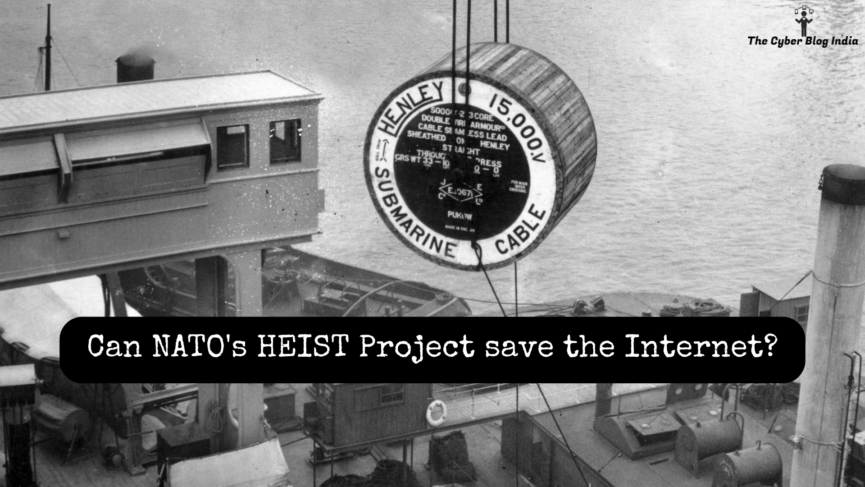Can NATO’s HEIST Project save the Internet?

Imagine a day when the Internet just stops working in your country. You cannot send messages, watch videos, or even access your bank account. Sounds scary, right? That’s precisely what could happen if the undersea cables that power most of the world’s internet are damaged or hacked. You might as well ask why. Well, these cables are massive fibre-optic lines lying deep under the ocean, carrying almost all of our online data between continents. But they are surprisingly vulnerable as ships or natural disasters can damage them, or in some cases, bad actors might try to cut them on purpose.
That’s where NATO’s proposed HEIST project comes into play. It ensures that the Internet keeps running smoothly even when these undersea cables get damaged or destroyed. Introduced on July 31, 2024, this project aims to develop a prototype within the next two years.
The HEIST Project
HEIST stands for Hybrid Space/Submarine Architecture Ensuring Infosec of Telecommunications. It combines the power of satellites with underwater cables to create a backup system. If the cables get damaged or destroyed due to a natural disaster, the internet traffic can automatically switch to satellites instead and prevent any major disruptions.
NATO commenced the HEIST project with a budget of $2.5 million, partly funded by their own Science for Peace and Security Programme (SPS). The initiative works to enhance both the strength and security of internet connections in critical facilities that depend on continuous service, such as hospitals, financial institutions, and military bases. The HEIST project focuses on creating detection systems capable of quickly finding and identifying cable damages. With this systems, engineers would be able to identify the precise location of a problem to a distance of metres, thus enabling rapid maintenance and repair.
The implementation of this revolutionary idea requires HEIST to assemble technical experts from academic institutions and technology enterprises worldwide. At present, various educational institutions, including John Hopkins University and Cornell University from the US, are working with multiple experts from Sweden, Iceland, and Switzerland to develop the prototype. Moreover, companies like SpaceX and Viasat, along with other companies specialised in satellite communication, are expected to play a significant role in the project. Testing of the system will commence during the two years following its construction stage with initial trials being conducted within Sweden.
Is it a fairytale?
The HEIST project presents itself as an appealing solution, yet faces multiple debates in terms of challenges and criticism. Firstly, the use of satellites as a backup for undersea cables provides insufficient because they lack both speed and capacity to manage vast internet traffic. The speed of data transfer through undersea cables reaches terabits per second, but satellite connections perform worse by maintaining slower transmission speeds, together with higher latency and reduced bandwidth. The adoption of satellite internet to support undersea cable failures would, hence, face unforeseen hurdles due to the technical limitations of satellite technology.
Geopolitics
It is difficult to navigate through the ever-evolving geopolitics. The military alliance among Western nations, which constitutes NATO, cannot collaborate with all nations to implement this project. The HEIST project unfolds as one element inside global efforts to fragment Western control over internet infrastructures since China and Russia are already operating separate networks. The HEIST project, rather than being a neutral technological endeavour, might be perceived as a tool for Western geopolitical influence, leading to internal divisions within NATO and greater global internet fragmentation.
Cyber Security and Militarisation
There are also concerns about cyber security and militarisation. The inclusion of satellite communications into vital internet systems by the HEIST project presents new potential risks since satellites may become prime targets for destructive cyber attacks. Moreover, the recent years have shown cyber warfare developing into a rising danger that pursues both power grid systems and government IT platforms. Hence, a successful exploitation of satellite networks in the HEIST project by adversaries may result in major internet service disruptions. In addition, several analysts also express concern that this project could serve dual purposes between civilian internet safety and military surveillance operations.
Cost and Implementation
Maintaining and expanding this hybrid network over time will require much more than $2.5 million. Questions remain about who will pay for long-term upkeep and who will control the technology, as a financial stakeholder. If this system becomes heavily reliant on companies like SpaceX and Viasat, it could also raise questions about corporate control over global communications, hence again, intertwining with geopolitics.
Future of the HEIST Project
Despite all this, the core idea and its aim of a more secure internet is still important and relevant. As technology advances and the use of the Internet becomes heavily indispensable, projects like this will become necessary. However, for the HEIST project to practically work, it will need to improve satellite technology, stakeholder cooperation, and cyber security. However, it may be practically impossible given the current state of geopolitics and a lack of strong government collaboration in both space and undersea. Whatever happens, one thing is for sure: the practically applicability of the HEIST project might trigger a war for the Internet. Can we handle that? What are your thoughts?
